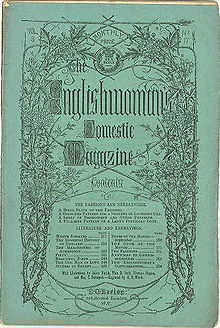
The Englishwoman's Domestic Magazine (EDM) was a monthly magazine which was published between 1852[1] and 1879.[2] Initially, the periodical was jointly edited by Isabella Mary Beeton and her husband Samuel Orchart Beeton, with Isabella contributing to sections on domestic management, fashion, embroidery and even translations of French novels.[3] Some of her contributions were later collected to form her widely acclaimed Book of Household Management.[4] The editors sought to inform as well as entertain their readers; providing the advice of an 'encouraging friend' and 'cultivation of the mind'[5] alongside serialised fiction, short stories and poetry. More unusually, it also featured patterns for dressmaking.
Originally priced at 2d, the periodical was a relatively cheap option for young, middle-class women. In 1860, however, following the Paper Tax abolition, the Beeton's decided to take the publication in a slightly different direction; opting to relaunch in a larger format and include high quality coloured plates.[6] Subsequently, the price of the magazine rose to 6d.
In 1865, following the death of Isabella Beeton, the magazine was co-edited by her friend, Matilda Brown.
In 1867, Beeton expanded the existing correspondence section of the magazine. The contents of this "Conversazione", now included contributions by men, included material extolling the attractions of corsetry[7]/tight-lacing, cross-dressing[8] and flagellation;[9] extracts on the latter were republished in pornographic compilations such as The Birchen Bouquet.[10]
- ^ Margaret Beetham (2004). "Beeton, Samuel Orchart (1831-1877)". Oxford Dictionary of National Biography. Oxford University Press. Retrieved 4 October 2010.
- ^ Albert Johannsen (1950). "Beeton, Samuel Orchart". The House of Beadle & Adams and its Dime and Nickel Novels: The Story of a Vanished Literature. Vol. II. University of Oklahoma Press. pp. 32–33.
- ^ "British Library". www.bl.uk. Retrieved 2022-06-11.
- ^ Beetham, Margaret; Boardman, Kay (2001). Victorian women's magazines: an anthology. Manchester University Press. pp. 32, 36. ISBN 978-0-7190-5879-0.
- ^ "Our Address". The Englishwoman's Domestic Magazine. 1 (1): 1. 1852 – via Nineteenth Century UK Periodicals.
- ^ Onslow, Barbara (2000). Women of the press in nineteenth-century Britain. New York: St. Martin's Press. ISBN 0-312-23602-6. OCLC 44075916.
- ^ Margaret Beetham (1991). "'Natural but firm': the corset correspondence in the Englishwoman's Domestic Magazine". Women: A Cultural Review. 2 (2): 163–167. doi:10.1080/09574049108578076.
- ^ Ekins, Richard; King, Dave (1996). Blending genders: social aspects of cross-dressing and sex-changing. Routledge. pp. 10–11. ISBN 978-0-415-11552-0.
- ^ Marcus 2007, p. 16.
- ^ Kathryn Hughes (2001). The Victorian governess. Continuum International Publishing Group. p. 137. ISBN 978-1-85285-325-9.
